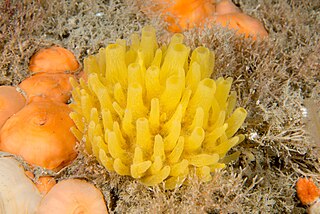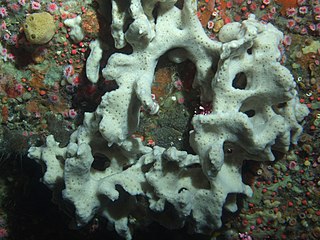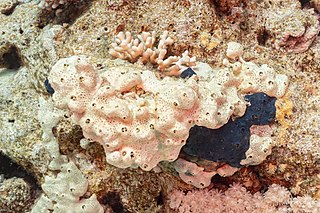
Geodia is a genus of sea sponge belonging to the family Geodiidae. It is the type genus of its taxonomic family.

Polymastia is a genus of sea sponges containing about 30 species. These are small to large encrusting or dome-shaped sponges with a smooth surface having many teat-shaped projections (papillae). In areas of strong wave action, this genus does not grow the teat structures, but instead grows in a corrugated form.

Spongia is a genus of marine sponges in the family Spongiidae, originally described by Carl Linnaeus in 1759, containing more than 60 species. Some species, including Spongia officinalis, are used as cleaning tools, but have mostly been replaced in that use by synthetic or plant material.

Axinella is a genus of sponges in the family Axinellidae first described in 1862 by Eduard Oscar Schmidt. Species of Axinella occur in the Indian and Pacific Oceans. Most of these sponges are smaller than 20 cm, and have a yellow or orange colour.
Hymeniacidon is a genus of sea sponges in the class Demospongiae. Some members of the genus are known to be mobile, achieving speeds of between 1 and 4 mm per day.

Stelletta is a genus of sea sponges belonging to the family Ancorinidae.

Tethya is a genus of sea sponges belonging to the family Tethyidae. Members of this genus all have a spherical body form and some are known to be able to move at speeds of between 1 and 4 mm per day.

Clathria is a large genus of demosponges in the family Microcionidae.
Biemna is a genus of sea sponges in the family Biemnidae.

Haliclona is a genus of demosponges in the family Chalinidae.

Ircinia is a genus of sea sponges in the family Irciniidae.

Myxilla is a genus of demosponge belonging to the family Myxillidae. These sponges usually form encrustations on rock surfaces.

Callyspongia is a genus of demosponges in the family Callyspongiidae.

Crella is a genus of marine demosponges in the family Crellidae.

Clathria (Clathria) is a subgenus of demosponge in the family Microcionidae.

Tedania is a genus of sea sponges in the family Tedaniidae.

Mycale is a genus of demosponge with 240 recognised species in 11 subgenera. It has been a large genus with multiple subdivisions since it was first described in 1867.

Antho is a genus of sponges belonging to the family Microcionidae. The genus has a cosmopolitan distribution and is known from virtually all parts of the global ocean. There are 62 species in five subgenera.

Phorbas is a genus of demosponges belonging to the family Hymedesmiidae.

Latrunculia is a genus of demosponges. It is well known for the diverse array of chemical compounds found in its species, including the latrunculins, which are named after this genus. Many of these are medically important, including anti-cancer compounds such as discorhabdins.

















